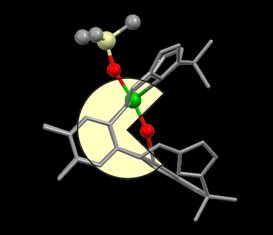'Pac-Man' molecule munches uranium
18 January 2008
Researchers have designed a molecule that can "eat" and then "trick" uranium into behaving like a lighter atom. The molecule, which is a "Pac-Man lookalike" could open thedoor for future developments in nuclear waste management or novel usesof uranium.
 In solution, uranium forms the notoriously stable and highly water-soluble uranyl ion, in which uranium is bound to two atoms of oxygen. The incredible strength of the uranium-oxygen bonds make it very unreactive, and, coupled with its high solubility in water, makes it very difficult to remove from water in the environment.
In solution, uranium forms the notoriously stable and highly water-soluble uranyl ion, in which uranium is bound to two atoms of oxygen. The incredible strength of the uranium-oxygen bonds make it very unreactive, and, coupled with its high solubility in water, makes it very difficult to remove from water in the environment.
Husband-and-wife team Jason Love and Polly Arnold, both scientists at the University of Edinburgh, have developed a macrocycle - imagine a piece of molecular scaffolding - which they say is shaped like Pac-Man videogame character of the 1980s. The macrocycle grips the uranium and one of the oxygen atoms in its "mouth", leaving the other oxygen atom sticking out. The protruding oxygen atom can then be made to react with organic compounds in unusual new ways.
Although this sort of chemistry is common in enzymes and industrial catalysts using lighter metals, it is the first time it has been done with uranium. "We have found a way to trick uranium into behaving like a lighter metal," said Arnold. The macrocycle, as it stands, is not sufficiently stable in water for it to be used to remove uranyl from solutions, but the discovery should have long-term benefits for nuclear research. The behaviour of the "tricked" uranium might help environmental scientists discover new ways of removing uranium from contaminated water. It can also be used to help predict more accurately the behaviour of uranium's more reactive relative plutonium.
Arnold is enthusiastic that the discovery can benefit future research, hoping that it may perhaps spark the imaginations of other scientists and help them to think differently about the chemical behaviour of uranium in the environment. "Anything we can do to challenge preconceptions of how such molecules behave helps in the long run," she told World Nuclear News, adding that the macrocycle-uranyl complex would provide a useful model for intermediates in more complex systems typical of those encountered in waste streams from the different stages of the nuclear fuel cycle from uranium mining through to spent fuel processing.